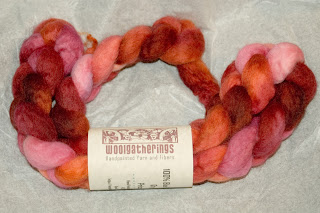I haven't bought spinning fiber (or yarn) in a very long time because I still have a ton of wool that I bought when I was working full time. I had stopped spinning and knitting for a while (see this post), but in recent months I have been able to get back to it, as I have with my knitting. On the plus side, I'm not likely to run out of wool any time soon, and have enough for many pairs of toasty wool socks. The down side is that almost all of it was purchased as raw fleece, and while it was washed ages ago when I bought it, it still needs to be carded before I can spin it.
Unfortunately I have found that while I love the look and smell of a (fresh and well-skirted!) raw fleece, I am bored to tears by the carding/combing process. This makes it difficult to spontaneously decide "I feel like spinning tonight!" I need to spend several days carding the wool before I have enough to spin, and if I'm tired and don't feel like breaking out the carding equipment, it doesn't get done. I've debated selling off the drum carder, but then I remember that there are some breeds of sheep that can only be acquired as unprocessed fleece. My compromise is that in the future I'll only buy a raw fleece if it's something special I can't get commercially prepared.
As with the rest of the world, fashions come and go within various crafts. When I had been more actively involved, the "in" thing to do with multicolored tops like the one pictured was to Navajo-ply it to preserve the appearance of the color repeats. This was also about the time when self-patterning "fair isle" yarns were being introduced, and people thought the idea of yarns that made stripes without having to weave in extra ends was kind of cool.
Current spinning fashion is shifting towards more subtle color changes. In the Summer 2007 issue, Spin-Off magazine published an article on a technique the author called "fractal spinning." With this technique you split the spinning fiber lengthwise into strips of varied thickness, with the thicker sections providing longer color repeats than the thinner ones. When the resultant singles are plied together you end up with the longer color repeats acting as a sort of unifying background to the shorter color repeats, with the net effect being that the transitions between color changes in the finished piece are much softer. This was my first opportunity to try this technique.
I decided that I wanted a 3-ply fingering-weight yarn for socks. I split the tops into thirds, with one third left whole, and the other two split into two and three parts. You can see the difference the splitting makes in the singles!
Here's the yarn I ended up with - a lovely, drapey light-fingering-weight 3-ply.
I chose to knit a pair of Kai-Mei socks from Cookie A.'s book Sock Innovation: Knitting Techniques & Patterns for One-of-a-Kind Socks
As you can see, while there are definitely stripes, they have much softer edges than they would if the color transitions had been more abrupt. I may still have projects that want defined stripes, but it's nice to be able to choose a middle ground.
















There you are! LOVELY fiber! Nice socks, too - I love seeing any part of the spinning process, I know nothing now, but this seems like something I would get mixed up in a few years from now LOL. The new style you are talking about, is that like the "Lumpy Bumpy" style?
ReplyDeleteAwesome post. Cool wool, beautiful work, wonderful socks, great pics.
ReplyDeleteThank you! I've barely taken them off since I finished them - especially since we've had below-zero temps at night the last few days!
ReplyDeleteErin - this is like "lumpy bumpy" in that it's a trend in spinning, but the technique is more about controlling distribution of color than about physical texture.
"Varying thickness" refers to each section I've split off relative to the others. The thickness of each individual section is is still fairly consistent along the length.
I could still choose to make a "lumpy bumpy" yarn with this technique if I wanted it - that effect is controlled by how many fibers you let get twisted into the yarn at a time. I wanted socks, so I chose to spin a smooth yarn this time.
If you want to email me your snail mail addy I'll send you a spinning Care Package!
How cool is that?! And I'll send you a batch of seeds LOL!
ReplyDeleteWhat a neat trick! I'm inspired to spin sock yarn using this technique. Thanks for a great post!
ReplyDeleteThis comment has been removed by a blog administrator.
ReplyDelete